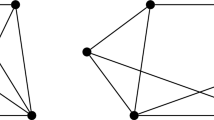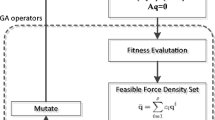Abstract
We propose a novel graph-theoretical method for efficient generation of the topological structure of N-frequency geodesic icosahedron tensegrities. The method only requires the adjacency list of edges of an N-frequency icosahedron, and using a sophisticated approach, creates the major topological entities of the corresponding geodesic icosahedron tensegrity. The graph theory is used to build a bridge between a regular icosahedron and its dual complex tensegrity. The approach proposed is general and perfectly works on icosahedrons with any degree of frequency. The generation of edges is managed in such a way that enables us to group them in different sets as cables and struts. The spherical geodesic tensegrities generated using our method could remarkably extend the complex data sets and large-scale benchmark models required for researchers in the field of tensegrity structures. The whole process and its parts are described and illustrated step by step. Furthermore, the form-finding of 1 to 5-frequency geodesic icosahedron tensegrities is also performed, and sets of self-equilibrium force densities corresponding to their super-stable geometries are provided. The results clearly demonstrate the effectiveness of the proposed method for automated modelling of the icosahedron tensegrities with a chosen frequency.







Similar content being viewed by others
Explore related subjects
Discover the latest articles and news from researchers in related subjects, suggested using machine learning.References
Sultan C (2009) Chapter 2 tensegrity: 60 years of art, science, and engineering. Advances in applied mechanics. Elsevier, Amsterdam, pp 69–145
Tibert AG, Pellegrino S (2002) Deployable tensegrity reflectors for small satellites. J Spacecr Rockets 39:701–709
Yildiz K, Lesieutre GA (2022) Sizing and prestress optimization of Class-2 tensegrity structures for space boom applications. Eng Comput 38:1451–1464
Yildiz K, Lesieutre GA (2020) Deployment of n-strut cylindrical tensegrity booms. J Struct Eng 146:4020247
Chen M, Goyal R, Majji M, Skelton RE (2021) Deployable tensegrity lunar tower. Earth and Space 2021:1079–1092
Chen M, Goyal R, Majji M, Skelton RE (2021) Review of space habitat designs for long term space explorations. Prog Aerosp Sci 122:100692
Liu K, Wu J, Paulino GH, Qi HJ (2017) Programmable deployment of tensegrity structures by stimulus-responsive polymers. Sci Rep 7:3511
Motro R (2003) Tensegrity: structural systems for the future. Butterworth-Heinemann, London
Rhode-Barbarigos L, Ali NBH, Motro R, Smith IFC (2010) Designing tensegrity modules for pedestrian bridges. Eng Struct 32:1158–1167
Fraternali F, Santos F (2019) Mechanical modeling of superelastic tensegrity braces for earthquake-proof structures. Extrem Mech Lett 33:100578
Skelton RE, Fraternali F, Carpentieri G, Micheletti A (2014) Minimum mass design of tensegrity bridges with parametric architecture and multiscale complexity. Mech Res Commun 58:124–132
Quirant J, Kazi-Aoual MN, Motro R (2003) Designing tensegrity systems: the case of a double layer grid. Eng Struct 25:1121–1130
Rhode-Barbarigos L, Jain H, Kripakaran P, Smith IFC (2010) Design of tensegrity structures using parametric analysis and stochastic search. Eng Comput 26:193–203
Shea K, Fest E, Smith IFC (2002) Developing intelligent tensegrity structures with stochastic search. Adv Eng Informatics 16:21–40
Moored KW, Kemp TH, Houle NE, Bart-Smith H (2011) Analytical predictions, optimization, and design of a tensegrity-based artificial pectoral fin. Int J Solids Struct 48:3142–3159
Luo Y, Xu X, Lele T et al (2008) A multimodular tensegrity model of an actin stress fiber. J Biomech 41:2379–2387
Ingber DE (2003) Tensegrity I. Cell structure and hierarchical systems biology. J Cell Sci 116(7):1157–1173
Zhang L-Y, Zheng Y, Yin X et al (2022) A tensegrity-based morphing module for assembling various deployable structures. Mech Mach Theory 173:104870
Ingber DE, Wang N, Stamenović D (2014) Tensegrity, cellular biophysics, and the mechanics of living systems. Reports Prog Phys 77:46603
Liu Y, Bi Q, Yue X et al (2022) A review on tensegrity structures-based robots. Mech Mach Theory 168:104571
Kobayashi R, Nabae H, Endo G, Suzumori K (2022) Soft tensegrity robot driven by thin artificial muscles for the exploration of unknown spatial configurations. IEEE Robot Autom Lett 7:5349–5356
Ma Y, Zhang Q, Dobah Y et al (2018) Meta-tensegrity: design of a tensegrity prism with metal rubber. Compos Struct 206:644–657
Fraternali F, Carpentieri G, Amendola A et al (2014) Multiscale tunability of solitary wave dynamics in tensegrity metamaterials. Appl Phys Lett 105:201903
Fraternali F, Senatore L, Daraio C (2012) Solitary waves on tensegrity lattices. J Mech Phys Solids 60:1137–1144
Rimoli JJ, Pal RK (2017) Mechanical response of 3-dimensional tensegrity lattices. Compos Part B Eng 115:30–42
Liu K, Zegard T, Pratapa PP, Paulino GH (2019) Unraveling tensegrity tessellations for metamaterials with tunable stiffness and bandgaps. J Mech Phys Solids 131:147–166
De Tommasi D, Marano GC, Puglisi G, Trentadue F (2017) Morphological optimization of tensegrity-type metamaterials. Compos Part B Eng 115:182–187
Zhang J, Ohsaki M, Rimoli JJ, Kogiso K (2021) Optimization for energy absorption of 3-dimensional tensegrity lattice with truncated octahedral units. Compos Struct 267:113903
Bauer J, Kraus JA, Crook C et al (2021) Tensegrity metamaterials: toward failure-resistant engineering systems through delocalized deformation. Adv Mater 33:2005647
Koohestani K (2017) On the analytical form-finding of tensegrities. Compos Struct 166:114–119
Zhang L-Y, Zhu S-X, Li S-X, Xu G-K (2018) Analytical form-finding of tensegrities using determinant of force-density matrix. Compos Struct 189:87–98
Zhang LY, Zhu SX, Chen XF, Xu GK (2019) Analytical form-finding for highly symmetric and super-stable configurations of rhombic truncated regular polyhedral tensegrities. J Appl Mech Trans ASME 86:031006
Zhang JY, Ohsaki M, Tsuura F (2019) Self-equilibrium and super-stability of truncated regular hexahedral and octahedral tensegrity structures. Int J Solids Struct 161:182–192
Zhang L-Y, Li Y, Cao Y et al (2012) Self-equilibrium and super-stability of truncated regular polyhedral tensegrity structures: a unified analytical solution. Proc R Soc A Math Phys Eng Sci 468:3323–3347
Tibert AG, Pellegrino S (2003) Review of form-finding methods for tensegrity structures. Int J Sp Struct 18:209–223
Zhang JY, Ohsaki M (2012) Self-equilibrium and stability of regular truncated tetrahedral tensegrity structures. J Mech Phys Solids 60:1757–1770
Zhang JY, Ohsaki M (2006) Adaptive force density method for form-finding problem of tensegrity structures. Int J Solids Struct 43:5658–5673
Estrada GG, Bungartz H-J, Mohrdieck C (2006) Numerical form-finding of tensegrity structures. Int J Solids Struct 43:6855–6868
Tran HC, Lee J (2010) Advanced form-finding of tensegrity structures. Comput Struct 88:237–246
Tran HC, Lee J (2011) Form-finding of tensegrity structures with multiple states of self-stress. Acta Mech 222:131
Koohestani K, Guest SD (2013) A new approach to the analytical and numerical form-finding of tensegrity structures. Int J Solids Struct 50:2995–3007
Wang Y, Xu X, Luo Y (2021) Form-finding of tensegrity structures via rank minimization of force density matrix. Eng Struct 227:111419
Tkachuk A (2022) Robustness of rank minimization heuristics for form-finding of tensegrity structures. Comput Struct 266:106786
Bui HQ, Kawabata M, Van NC (2022) A combination of genetic algorithm and dynamic relaxation method for practical form-finding of tensegrity structures. Adv Struct Eng 25:2237–2254
Zhang P, Zhou J, Chen J (2021) Form-finding of complex tensegrity structures using constrained optimization method. Compos Struct 268:113971
Zhang L-Y, Li Y, Cao Y-P, Feng X-Q (2014) Stiffness matrix based form-finding method of tensegrity structures. Eng Struct 58:36–48
Song K, Scarpa F, Schenk M (2022) Form-finding of tessellated tensegrity structures. Eng Struct 252:113627
Chen Y, Feng J, Wu Y (2012) Novel form-finding of tensegrity structures using ant colony systems. J Mech Robot 4:31001
Do DTT, Lee S, Lee J (2016) A modified differential evolution algorithm for tensegrity structures. Compos Struct 158:11–19
Koohestani K (2012) Form-finding of tensegrity structures via genetic algorithm. Int J Solids Struct 49:739–747
Li Y, Feng X-Q, Cao Y-P, Gao H (2010) A Monte Carlo form-finding method for large scale regular and irregular tensegrity structures. Int J Solids Struct 47:1888–1898
Chen Y, Yan J, Feng J, Sareh P (2020) A hybrid symmetry–PSO approach to finding the self-equilibrium configurations of prestressable pin-jointed assemblies. Acta Mech 231:1485–1501
Lee S, Lieu QX, Vo TP, Lee J (2022) Deep neural networks for form-finding of tensegrity structures. Mathematics 10:1–27
Trinh DTN, Lee S, Kang J, Lee J (2022) Force density-informed neural network for prestress design of tensegrity structures with multiple self-stress modes. Eur J Mech—A/Solids 94:104584
Ohsaki M, Zhang JY (2015) Nonlinear programming approach to form-finding and folding analysis of tensegrity structures using fictitious material properties. Int J Solids Struct 69–70:1–10
Koohestani K (2020) Innovative numerical form-finding of tensegrity structures. Int J Solids Struct 206:304–313
Koohestani K (2013) A computational framework for the form-finding and design of tensegrity structures. Mech Res Commun 54:41–49
Wang Y, Xu X, Luo Y (2021) A unifying framework for form-finding and topology-finding of tensegrity structures. Comput Struct 247:106486
Kanno Y (2013) Exploring new tensegrity structures via mixed integer programming. Struct Multidiscip Optim 48:95–114
Xu X, Wang Y, Luo Y (2018) Finding member connectivities and nodal positions of tensegrity structures based on force density method and mixed integer nonlinear programming. Eng Struct 166:240–250
Aloui O, Flores J, Orden D, Rhode-Barbarigos L (2019) Cellular morphogenesis of three-dimensional tensegrity structures. Comput Methods Appl Mech Eng 346:85–108
Ma S, Chen M, Peng Z et al (2022) The equilibrium and form-finding of general tensegrity systems with rigid bodies. Eng Struct 266:114618
Murakami H, Nishimura Y (2001) Static and dynamic characterization of regular truncated icosahedral and dodecahedral tensegrity modules. Int J Solids Struct 38:9359–9381
Fuller RB (1982) Synergetics: explorations in the geometry of thinking. Estate of R. Buckminster Fuller, Sebastopol, CA
West DB. (2001) Introduction to graph theory. Prentice hall Upper Saddle River
Connelly R, Back A (1998) Mathematics and tensegrity: Group and representation theory make it possible to form a complete catalogue of “strut-cable” constructions with prescribed symmetries. Am Sci 86:142–151
Zhang JY, Ohsaki M (2007) Stability conditions for tensegrity structures. Int J Solids Struct 44:3875–3886
Connelly R. (2002) Tensegrity structures: why are They Stable? BT-rigidity theory and applications. In: Thorpe MF, Duxbury M (eds). Springer, US Boston MA, pp 47–54
Guest SD (2010) The stiffness of tensegrity structures. IMA J Appl Math 76:57–66
Cai J, Wang X, Yang R, Feng J (2018) Mechanical behavior of tensegrity structures with High-mode imperfections. Mech Res Commun 94:58–63
Author information
Authors and Affiliations
Corresponding author
Ethics declarations
Conflict of interest
The author has no competing interests to declare that are relevant to the content of this article.
Additional information
Publisher's Note
Springer Nature remains neutral with regard to jurisdictional claims in published maps and institutional affiliations.
Supplementary Information
Below is the link to the electronic supplementary material.
Rights and permissions
Springer Nature or its licensor (e.g. a society or other partner) holds exclusive rights to this article under a publishing agreement with the author(s) or other rightsholder(s); author self-archiving of the accepted manuscript version of this article is solely governed by the terms of such publishing agreement and applicable law.
About this article
Cite this article
Koohestani, K. Novel topological and geometrical modelling of N-frequency geodesic icosahedron tensegrities. Engineering with Computers 38, 5733–5745 (2022). https://doi.org/10.1007/s00366-022-01750-2
Received:
Accepted:
Published:
Issue Date:
DOI: https://doi.org/10.1007/s00366-022-01750-2




